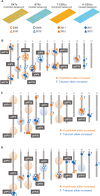Genetic architecture of leaf photosynthesis in rice revealed by different types of reciprocal mapping populations
- PMID: 31257428
- PMCID: PMC6793464
- DOI: 10.1093/jxb/erz303
Genetic architecture of leaf photosynthesis in rice revealed by different types of reciprocal mapping populations
Abstract
The improvement of leaf net photosynthetic rate (An) is a major challenge in enhancing crop productivity. However, the genetic control of An among natural genetic accessions is still poorly understood. The high-yielding indica cultivar Takanari has the highest An of all rice cultivars, 20-30% higher than that of the high-quality japonica cultivar Koshihikari. By using reciprocal backcross inbred lines and chromosome segment substitution lines derived from a cross between Takanari and Koshihikari, we identified three quantitative trait loci (QTLs) where the Takanari alleles enhanced An in plants with a Koshihikari genetic background and five QTLs where the Koshihikari alleles enhanced An in plants with a Takanari genetic background. Two QTLs were expressed in plants with both backgrounds (type I QTL). The expression of other QTLs depended strongly on genetic background (type II QTL). These beneficial alleles increased stomatal conductance, the initial slope of An versus intercellular CO2 concentration, or An at CO2 saturation. Pyramiding of these alleles consistently increased An. Some alleles positively affected biomass production and grain yield. These alleles associated with photosynthesis and yield can be a valuable tool in rice breeding programs via DNA marker-assisted selection.
Keywords: Backcross inbred line; chromosome segment substitution line; nitrogen content; phenology; photosynthesis; quantitative trait locus; reciprocal mapping population; rice; stomatal conductance; yield.
© The Author(s) 2019. Published by Oxford University Press on behalf of the Society for Experimental Biology.
Figures







Similar articles
-
Genetic mechanisms underlying yield potential in the rice high-yielding cultivar Takanari, based on reciprocal chromosome segment substitution lines.BMC Plant Biol. 2014 Nov 18;14:295. doi: 10.1186/s12870-014-0295-2. BMC Plant Biol. 2014. PMID: 25404368 Free PMC article.
-
A novel QTL associated with rice canopy temperature difference affects stomatal conductance and leaf photosynthesis.Breed Sci. 2018 Jun;68(3):305-315. doi: 10.1270/jsbbs.17129. Epub 2018 Jun 29. Breed Sci. 2018. PMID: 30100797 Free PMC article.
-
Do the rich always become richer? Characterizing the leaf physiological response of the high-yielding rice cultivar Takanari to free-air CO2 enrichment.Plant Cell Physiol. 2014 Feb;55(2):381-91. doi: 10.1093/pcp/pcu009. Epub 2014 Jan 18. Plant Cell Physiol. 2014. PMID: 24443497 Free PMC article.
-
Genetic dissection of agronomically important traits in closely related temperate japonica rice cultivars.Breed Sci. 2017 Dec;67(5):427-434. doi: 10.1270/jsbbs.17053. Epub 2017 Nov 15. Breed Sci. 2017. PMID: 29398936 Free PMC article. Review.
-
Gene Pyramiding Strategies for Sink Size and Source Capacity for High-Yield Japonica Rice Breeding.Rice (N Y). 2025 Feb 13;18(1):6. doi: 10.1186/s12284-025-00756-w. Rice (N Y). 2025. PMID: 39945924 Free PMC article. Review.
Cited by
-
Photosynthesis in a Changing Global Climate: Scaling Up and Scaling Down in Crops.Front Plant Sci. 2020 Jul 6;11:882. doi: 10.3389/fpls.2020.00882. eCollection 2020. Front Plant Sci. 2020. PMID: 32733499 Free PMC article. Review.
-
Whole-genome de novo assemblies reveal extensive structural variations and dynamic organelle-to-nucleus DNA transfers in African and Asian rice.Plant J. 2020 Nov;104(3):596-612. doi: 10.1111/tpj.14946. Epub 2020 Aug 27. Plant J. 2020. PMID: 32748498 Free PMC article.
-
Genome-wide association study of leaf photosynthesis using a high-throughput gas exchange system in rice.Photosynth Res. 2024 Jan;159(1):17-28. doi: 10.1007/s11120-023-01065-3. Epub 2023 Dec 19. Photosynth Res. 2024. PMID: 38112862
-
Rice Cultivar Takanari Has Higher Photosynthetic Performance Under Fluctuating Light Than Koshihikari, Especially Under Limited Nitrogen Supply and Elevated CO2.Front Plant Sci. 2020 Sep 1;11:1308. doi: 10.3389/fpls.2020.01308. eCollection 2020. Front Plant Sci. 2020. PMID: 32983198 Free PMC article.
-
A model-guided holistic review of exploiting natural variation of photosynthesis traits in crop improvement.J Exp Bot. 2022 May 23;73(10):3173-3188. doi: 10.1093/jxb/erac109. J Exp Bot. 2022. PMID: 35323898 Free PMC article. Review.
References
-
- Adachi S, Nakae T, Uchida M, et al. . 2013. The mesophyll anatomy enhancing CO2 diffusion is a key trait for improving rice photosynthesis. Journal of Experimental Botany 64, 1061–1072. - PubMed
-
- Adachi S, Nito N, Kondo M, Yamamoto T, Arai-Sanoh Y, Ando T, Ookawa T, Yano M, Hirasawa T. 2011a Identification of chromosomal regions controlling the leaf photosynthetic rate in rice by using a progeny from japonica and high-yielding indica varieties. Plant Production Science 14, 118–127.
-
- Adachi S, Yoshikawa K, Yamanouchi U, Tanabata T, Sun J, Ookawa T, Yamamoto T, Sage RF, Hirasawa T, Yonemaru J. 2017. Fine mapping of Carbon Assimilation Rate 8, a quantitative trait locus for flag leaf nitrogen content, stomatal conductance and photosynthesis in rice. Frontiers in Plant Science 8, 60. - PMC - PubMed
Publication types
MeSH terms
LinkOut - more resources
Full Text Sources

